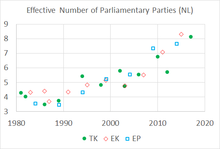
Back Nombre efectiu de partits polítics Catalan Efektivní počet stran Czech Effektive Parteienzahl German Nombre effectif de partis French Jumlah partai efektif ID Indice di Laakso-Taagepera Italian 유효정당수 Korean Эффективное число партий Russian
In political science, the effective number of parties is a diversity index introduced by Laakso and Rein Taagepera (1979),[1] which provides for an adjusted number of political parties in a country's party system, weighted by their relative size. The measure is especially useful when comparing party systems across countries.[2]
The size of a party can be measured by either:
- The effective number of electoral parties (ENEP) weights parties by their share of the vote.
- The effective number of parliamentary parties (ENPP) weights parties by their share of seats in the legislature.
The number of parties equals the effective number of parties only when all parties have equal strength. In any other case, the effective number of parties is lower than the actual number of parties. The effective number of parties is a frequent operationalization for political fragmentation. Political concentration can seen as the share of power of large political parties.[3]

There are several common alternatives for how to define the effective number of parties.[4] John K. Wildgen's index of "hyperfractionalization" accords special weight to small parties.[5] Juan Molinar's index gives special weight to the largest party.[6] Dunleavy and Boucek provide a useful critique of the Molinar index.[7]
- ^ Laakso, Markku; Taagepera, Rein (1979). ""Effective" Number of Parties: A Measure with Application to West Europe". Comparative Political Studies. 12 (1): 3–27. doi:10.1177/001041407901200101. ISSN 0010-4140. S2CID 143250203.
- ^ Lijphart, Arend (1999): Patterns of Democracy. New Haven/London: Yale UP
- ^ Avila-Cano, Antonio; Triguero-Ruiz, Francisco (2024). "Concentration of political power: Can we improve its measurement?". Comparative European Politics. 22 (3): 389–407. doi:10.1057/s41295-023-00365-1. ISSN 1472-4790.
- ^ Arend Lijphart (1 January 1994). Electoral Systems and Party Systems: A Study of Twenty-seven Democracies, 1945–1990. Oxford University Press. p. 69. ISBN 978-0-19-827347-9.
- ^ Wildgen, John K. (1971-07-01). "The Measurement of Hyperfractionalization". Comparative Political Studies. 4 (2). Cps.sagepub.com: 233–243. doi:10.1177/001041407100400205. Retrieved 2014-01-05.
- ^ Molinar, Juan (1 January 1991). "Counting the Number of Parties: An Alternative Index". The American Political Science Review. 85 (4): 1383–1391. doi:10.2307/1963951. JSTOR 1963951. S2CID 154924401.
- ^ Dunleavy, Patrick; Boucek, Françoise (2003). "Constructing the Number of Parties" (PDF). Party Politics. 9 (3): 291–315. doi:10.1177/1354068803009003002. S2CID 33028828.